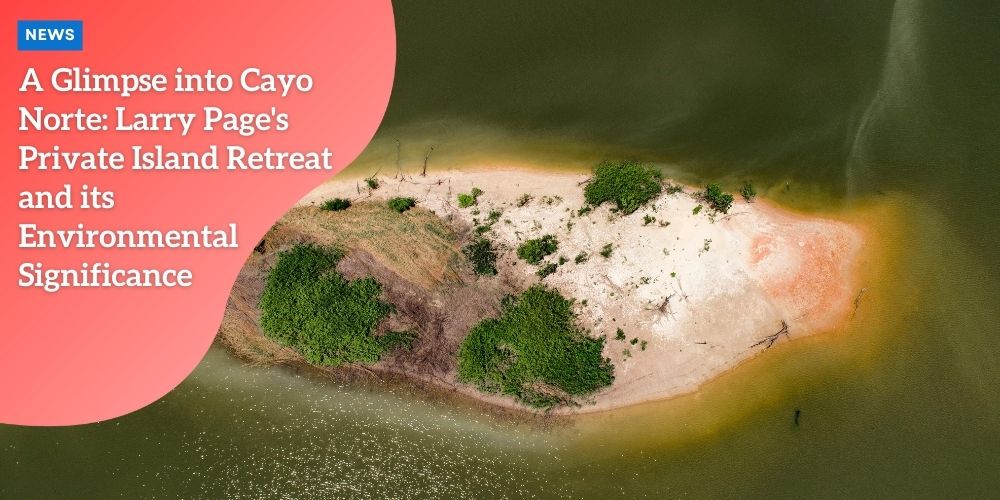A Glimpse into Cayo Norte: Larry Page’s Private Island Retreat and its Environmental Significance

Introduction
In the annals of private island acquisitions, Larry Page’s purchase of Cayo Norte in 2018 stands out prominently.
Anúncios
Valued at $32 million, this 300-acre oasis nestled near Puerto Rico’s shores captivates with its natural splendor and ecological richness.
Yet, beyond the headlines of a tech titan’s acquisition lies a narrative intertwined with profound ecological implications.
This event has sparked not only discussions about luxury and wealth but also about the impact of human ownership on fragile ecosystems and the delicate balance required to protect them.
Anúncios
Page’s acquisition of Cayo Norte transcends a mere financial transaction.
It underscores the complex intersection of wealth, environmental responsibility, and personal ambition.
The island’s untouched beauty and ecological value have drawn attention to the potential consequences of its stewardship by a private individual.
Anúncios
As we delve deeper into the details of Cayo Norte’s environmental significance and the broader context of island ownership, we are faced with a key question: can private ownership coexist with genuine ecological preservation? This question is central to understanding the implications of Larry Page’s decision and its potential legacy.
Larry Page’s Acquisition of Cayo Norte
Cayo Norte, with its azure waters caressing sandy beaches and bustling coral reefs, epitomizes Caribbean ecological marvels.
Larry Page’s acquisition of this gem symbolizes more than a mere asset addition; it signifies the fusion of opulence with natural magnificence.
While raising eyebrows for its substantial price tag, the purchase also sparks contemplation about potential impacts on the island’s pristine environment.
The island itself is relatively untouched by human influence, offering a rare glimpse into a Caribbean ecosystem largely undisturbed by modern development.
For Page, a figure whose innovations have shaped the technological landscape, the island represents something beyond a retreat from the public eye.
It is a space where he can foster his love for nature and potentially act as a steward of an endangered ecosystem.
However, the enormity of his acquisition has led some to question whether a billionaire tech mogul can truly balance the demands of private ownership with the needs of such an ecologically sensitive environment.
The island’s charm lies in its pristine state, but with ownership comes the risk of imposing human development that could alter its delicate natural balance.
The Ecological Significance of Cayo Norte
Cayo Norte’s ecological canvas is intricate and vibrant.
Beneath the waves, stunning reefs harbor a myriad of marine species, crafting underwater metropolises.
These coral reefs are some of the most biodiverse in the Caribbean, playing a crucial role in maintaining marine life, offering both shelter and sustenance to countless species of fish, mollusks, and other marine creatures.
Above the surface, the beaches serve as vital nesting grounds for sea turtles, enhancing the island’s status as a sanctuary.
Preserving such habitats is crucial, not just for the turtles, but also for sustaining the broader marine ecosystem’s health.
The island’s significance extends far beyond its picturesque appeal.
It is a sanctuary for endangered species and a hub of biodiversity that, in many ways, represents the fragile beauty of the Caribbean environment.
For sea turtles, Cayo Norte is an essential location for nesting, where they return year after year to lay their eggs in the sand.
The surrounding waters offer a rich environment for juvenile turtles to grow and mature before heading out to sea.
This intricate web of life, where each species relies on the other for survival, makes Cayo Norte a critical player in the broader ecosystem.
Larry Page’s Retreat from Public Life
Cayo Norte, beyond its ecological importance, serves as a retreat for Larry Page, who has gradually withdrawn from public prominence.
Witness accounts of hydrofoil boards skimming waters and helicopters landing hint at Page’s presence.
These glimpses into his island activities evoke curiosity about how a high-profile individual reconciles a low-profile lifestyle with a commitment to preserving such a unique environment.
Despite his low-key lifestyle on the island, Page’s acquisition of Cayo Norte highlights a fascinating contrast between public recognition and personal privacy.
The island has served as a haven from the glare of the public eye, yet it is surrounded by the ongoing debate over the role of wealthy individuals in shaping the future of our planet’s ecological health.
How does one balance the desire for personal freedom with the weight of responsibility that comes with owning such a rare and delicate piece of land? As Page retreats from the public spotlight, his presence on Cayo Norte raises questions about the ethical considerations of his ownership.
The Ecological Importance of Cayo Norte
Within the local ecosystem, Cayo Norte emerges not merely as land, but as a pivotal component in ecological machinery.
The island’s position in the Caribbean Sea provides refuge for various marine life, particularly sea turtles, which gravitate to its shores for nesting—an integral aspect of their life cycle.
These beaches serve as a critical environment for nesting turtles to lay their eggs in the sand, a practice that has continued for millions of years.
As the turtles return year after year, they help maintain the integrity of the local ecosystem by facilitating nutrient cycling and contributing to the health of surrounding marine environments.
Beyond the nesting turtles, the island’s coral reefs also play a significant role in maintaining biodiversity.
These reefs are home to a wide variety of marine life, from colorful fish to invertebrates and other organisms that rely on the reef system for food and protection.
The delicate balance of these ecosystems is dependent on the ongoing health of the coral reefs, which are vulnerable to environmental stressors such as climate change, pollution, and overfishing.
Protecting the reefs of Cayo Norte is therefore essential to maintaining the broader health of the Caribbean marine ecosystem.
Haven for Sea Turtles
Cayo Norte’s significance for sea turtles cannot be overstated.
Annually, female turtles return to their birthplace beaches to lay eggs, perpetuating a cycle spanning millions of years.
The island’s white sands offer an ideal setting for this ritual.
Yet, beyond the beaches, vibrant reefs in surrounding waters serve as biodiversity hubs, offering sustenance and shelter to countless marine species.
These turtle populations are increasingly endangered, and Cayo Norte’s role in their preservation is irreplaceable.
The island provides a safe, undisturbed environment where turtles can continue to reproduce, ensuring the survival of future generations.
Without such sanctuaries, sea turtle populations would be at even greater risk.
Many of the world’s sea turtle species face threats from habitat loss, poaching, and climate change.
For this reason, the protection of Cayo Norte’s beaches and surrounding marine environment is critical.
The island serves as a beacon of hope for these endangered creatures, offering a rare example of a relatively undisturbed environment where turtles can continue to thrive.
Impact of Human Activities
However, human presence introduces inevitable concerns about environmental impact.
Even seemingly benign recreational activities like boating can disturb wildlife or harm coral reefs.
Balancing enjoyment with preservation is delicate; any disturbance could reverberate across Cayo Norte and the broader Caribbean marine ecosystem.
While the island’s beauty and seclusion attract wealthy individuals like Page, it is vital to recognize that human presence—if not carefully managed—can disrupt the delicate balance of nature.
Human activities, such as the construction of infrastructure, the use of motorized vehicles, and the introduction of non-native species, can all have detrimental effects on the island’s natural environment.
The challenge for Page and future owners of Cayo Norte is to find ways to coexist with the land and its inhabitants without compromising the ecological integrity that makes the island so unique.
Conservation Concerns Amidst Ownership
Larry Page’s ownership of Cayo Norte has sparked apprehension among environmentalists and locals. Their concern revolves around the island’s natural value potentially being compromised.
Advocates stress the importance of preserving its beauty and ecological significance, unfettered by the footprints of privileged few.
As concerns over the future of the island mount, it becomes evident that ownership of such a rare and fragile place carries a heavy responsibility.
Cayo Norte represents a larger debate about the ethics of private ownership of ecologically significant lands.
Environmentalists argue that the wealthiest individuals should not have the right to monopolize access to such places, and that ownership should be aligned with a commitment to long-term conservation efforts.
The island’s future will depend on whether Page, and others in similar positions, choose to take on the mantle of stewardship and make decisions that prioritize the preservation of the natural world over personal gain.
Stewardship and Conservation Efforts
The pristine allure of Cayo Norte bears a weighty responsibility.
Environmentalists and residents await Page’s stewardship, hoping he prioritizes the island’s ecological well-being over development.
Their vision aligns with preserving Cayo Norte as a sanctuary for wildlife and a research hub for tropical ecosystems.
Conservationists have expressed hope that Page will use his resources to help fund research, support local environmental initiatives, and contribute to broader global efforts to protect marine biodiversity.
There is also the possibility of forming partnerships with scientific organizations or conservation groups to ensure that Cayo Norte is maintained as an ecologically sound environment.
Such partnerships could facilitate research projects on climate change, marine conservation, and ecosystem restoration, benefiting both the island and the scientific community at large.
Minimal Development Footprint
Since acquiring Cayo Norte, Page has left minimal impact.
The absence of sprawling villas or docks suggests a lighter, transient human presence.
This approach fosters cautious optimism, signaling respect for the island’s natural state and recognition of the delicate balance required for environmental sanctity.
While the lack of major development is encouraging, it is still unclear whether Page’s stewardship will extend to long-term conservation efforts or simply reflect a personal desire for solitude and luxury.
The fact that Page has refrained from extensive development on the island speaks to a broader trend among wealthy landowners who are increasingly prioritizing sustainability in their ownership practices.
For Cayo Norte, this minimal development approach offers a glimpse of what responsible ownership could look like—where the needs of the environment are placed at the forefront, and human impact is carefully managed.
Potential Conservation Strategies
Page possesses resources and innovation to preserve Cayo Norte’s ecosystem.
Collaborating with marine experts and investing in conservation projects could harmonize his presence with the island’s needs.
Embracing renewable energy and opening the island to scientific research may bolster conservation efforts.
Renewable energy sources like solar or wind power could significantly reduce the island’s environmental footprint, ensuring that the island remains as sustainable as possible.
Additionally, supporting local conservation initiatives and collaborating with global environmental organizations could further enhance the island’s role as a model for sustainable private ownership.
Page’s wealth and influence could be leveraged to fund large-scale conservation projects, not only on Cayo Norte but in the surrounding region as well.
Balancing Ownership and Environmental Impact
Owning Cayo Norte entails not just title deed, but moral responsibility.
The ethical imperative of stewardship looms large, highlighting the delicate balance between personal freedoms and environmental preservation.
The choices Page makes today will have lasting consequences on the island’s ecosystem and its future.
As a high-profile figure with significant resources, Page has the ability to set an example for others in his position.
His decisions regarding the management and development of Cayo Norte could influence the broader conversation about the intersection of wealth, privilege, and environmental stewardship.
Models of Sustainable Ownership
Exemplary cases of sustainable island ownership offer hope.
By implementing protection measures, restoration projects, and partnerships, owners can create legacies of ecological stewardship.
The idea of sustainable island ownership is not a novel concept—there are several instances where landowners have worked alongside conservationists to protect delicate ecosystems while still enjoying the benefits of private ownership.
For example, some islands have been turned into nature reserves, where scientific research is encouraged and conservation efforts are actively pursued.
These models demonstrate that it is possible for wealthy individuals to balance their personal interests with broader environmental goals.
Conclusion
Cayo Norte epitomizes the nexus of private ownership and environmental stewardship.
Page’s acquisition underscores the imperative of responsible island ownership.
Advocacy for awareness and action is crucial to safeguarding Cayo Norte and similar ecological treasures for future generations.
Let’s unite in a commitment to preserving our planet’s invaluable resources, ensuring their enduring beauty and richness for all to cherish.
The story of Cayo Norte and Larry Page’s acquisition serves as a reminder that the future of our planet depends on the choices made today.
With the right stewardship, islands like Cayo Norte can continue to thrive as havens for wildlife and biodiversity.
The responsibility of owning such a rare piece of land is immense, and it is up to individuals like Page to lead the way in setting a sustainable and ethical example for future generations.
By prioritizing conservation over development, we can ensure that the beauty of places like Cayo Norte remains preserved for generations to come.





